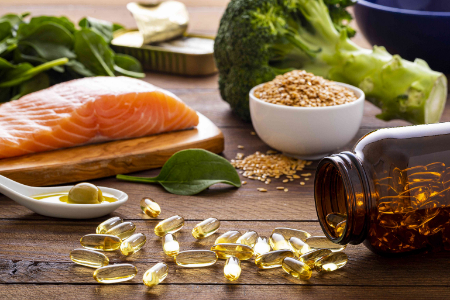The world of Omega 3; A comprehensive guide to types, benefits and uses
Omega-3 fatty acids are essential for maintaining good health. They are found in fish oil, oily fish and many other seafood. Other forms are found in some high-fat plant foods such as flaxseeds, flaxseed oil, walnuts, and chia seeds. Omega-3 fatty acids are essential fats that have many health benefits.
However, not all omega-3s are created equal. Among the 11 types, the 3 most important types are ALA, EPA and DHA. ALA is found mostly in plants, while EPA and DHA are mostly found in animal foods such as fatty fish. This article takes a close look at the 3 most important types of omega-3s.
Omega 3 types, uses of Omega 3 supplements
What are omega 3 fatty acids?
Omega-3 fatty acids are a type of polyunsaturated fat. They are considered essential fatty acids because they are needed for health but your body cannot make them. Therefore, you should get them through your diet. Instead of being stored and used for energy, omega-3 fatty acids play an important role in many body processes, including inflammation, heart health, and brain function.
Omega-3 deficiency has been linked to reduced intelligence, depression, heart disease, arthritis, cancer and many other health problems.
What do omega-3 fatty acids do?
Omega-3 fatty acids help all cells in your body function properly. They are a vital component of cell membranes and help create structure and support communication between cells. While omega-3s are important for all of your cells, they are most concentrated in eye and brain cells.
In addition, omega-3s provide energy (calories) for your body and support the health of many body systems, including the cardiovascular system and the endocrine system.
What are the types of omega 3 fatty acids?
There are three main types of omega-3 fatty acids:
• EPA (eicosapentaenoic acid): EPA is a “marine omega-3” because it is found in fish.
• DHA (docosahexaenoic acid): DHA is also a marine omega-3 found in fish.
• ALA (alpha-linolenic acid): ALA is a type of omega-3 found in plants.
Omega-3 fatty acids are essential nutrients that you must get through your diet. When you get ALA from food, your body is able to convert some of the ALA to EPA and then to DHA. However, this process provides only small amounts of EPA and DHA. Therefore, dietary sources of EPA and DHA (such as fish) are essential.

Types of Omega-3 Supplements
If you’re not getting enough omega-3s from your diet through fatty fish, you may want to consider taking omega-3 supplements. Omega-3 supplements come in many forms, from regular fish oil to mammalian oils. Omega-3 fatty acids are very important for your health. The best way to get enough omega-3s is to eat whole foods rich in them, such as fatty fish.
If you don’t eat a lot of oily fish, you may want to consider taking a supplement.
However, there are hundreds of different types of omega-3 supplements available. Not all of them have the same health benefits. This comprehensive guide explains everything you need to know about omega-3 supplements. Omega-3s come in several forms:
There are two forms of fish oil, natural and processed. Processing can affect the shape of fatty acids. This is important because some forms are absorbed better than others.
• Fish. In whole fish, omega-3 fatty acids are present as free fatty acids, phospholipids, and triglycerides.
• fish oil. In regular fish oils, omega-3 fatty acids are mostly in the form of triglycerides.
• Processed fish oil. When fish oil is refined, food chemists often convert the triglycerides into ethyl esters, allowing them to adjust the concentration of DHA and EPA in the oil.
• Modified triglycerides. The ethyl esters in processed fish oil can be converted back into triglycerides, which are called modified triglycerides.
All of these forms have health benefits, but studies show that omega-3s from ethyl esters are not as well absorbed as other forms, although some studies show that they are absorbed just as well.
Natural fish oil
This is an oil obtained from the tissue of oily fish, mostly in the form of triglycerides. This is the closest you can get to real fish. Natural fish oil contains several important nutrients. The amount of omega-3 in fish oil, including EPA and DHA, ranges from 18 to 31 percent, but the amount varies between fish species.
In addition, natural fish oil contains vitamins A and D.
Salmon, sardine, herring, menhaden and fish liver are the most common sources of natural fish oil. These oils are available in capsule or liquid form
Processed fish oil
Processed fish oil is purified and/or concentrated. It consists of ethyl esters or triglycerides. Oil purification removes contaminants such as mercury and PCBs. Oil concentrates can also increase EPA and DHA levels. In fact, some oils may contain 50-90% pure EPA and/or DHA.
Processed fish oils make up the vast majority of the fish oil market because they are inexpensive and usually come in capsules that are popular with consumers. Your body does not absorb processed fish oil as well as natural fish oil when it is in the ethyl ester form. Ethyl esters seem to be more susceptible to oxidation and acidification than triglycerides.
However, some manufacturers process the oil even further to turn it back into a synthetic triglyceride form that is better absorbed, these oils are called modified (or re-esterified) triglycerides. They are the most expensive fish oil supplements and only make up a small percentage of the market.

Krill oil:
Krill oil is extracted from Antarctic krill, a small shrimp-like animal. Krill oil contains omega-3 in both triglyceride and phospholipid forms. Numerous studies have shown that omega-3s are absorbed just as well, sometimes even better, from the phospholipids in krill oil as well as the triglycerides in fish oil.
Krill oil is highly resistant to oxidation because it naturally contains a powerful antioxidant called astaxanthin. In addition, krill are very small and short-lived, so they do not accumulate many pollutants during their lifetime. Therefore, their oil does not need to be refined and is rarely found in the ethyl ester form.
Green lip oyster oil:
Green lip oyster oil is native to New Zealand and its oil is usually in the form of triglycerides and free fatty acids. In addition to EPA and DHA, this oil also contains small amounts of eicosatetraenoic acid (ETA). This rare omega-3 fatty acid may be even more effective at reducing inflammation than other omega-3s. Using green lip oyster oil instead of fish oil is environmentally friendly.
Mammalian Oil:
Mammalian omega-3 oil is obtained from the body fat (fat under the skin) of animals such as seals and is in the form of natural triglycerides. In addition to EPA and DHA, this oil also contains relatively high amounts of docosapentanoic acid (DPA), an omega-3 fatty acid with several potential health benefits. Mammalian omega-3 oil is also exceptionally low in omega-6.
ALA Oil:
ALA stands for alpha-linolenic acid. This is the plant form of omega-3. This fatty acid is specifically found in large amounts in flaxseeds, chia seeds, and hemp. Your body can convert it into EPA or DHA, but this conversion process is not efficient. Also, most vegetable oils have more omega-6 than omega-3.
Algae oil:
Seaweeds, especially microalgae, are another source of triglycerides containing EPA and DHA. In fact, the EPA and DHA found in fish come from algae. These materials are eaten by smaller fish and move up the food chain from there.
Research shows that algae oil is even more concentrated in omega-3s than fish oil, especially DHA. This oil is an especially good source for vegetarians and vegans. It may also contain important minerals such as iodine.
In addition, algae oil is considered environmentally friendly. This oil does not contain any pollutants such as heavy metals, which makes it a sustainable and healthy option.
Omega-3 capsules:
Omega-3 oils are typically found in capsules or softgels. These are popular with consumers because they are tasteless and easy to swallow. Capsules are usually made of a soft gelatin layer, and many manufacturers also use an enteric coating. The enteric coating helps prevent the capsule from dissolving until it reaches the small intestine. This is common in fish oil capsules. This coating can also hide the unpleasant smell of rotten fish oil. If you’re taking omega-3 capsules, it’s a good idea to occasionally open a capsule and smell it to make sure it hasn’t gone bad.
What should we pay attention to when buying omega-3 supplements?
When buying an omega-3 supplement, always read the label carefully. Also check out the following:
√ Type of Omega-3: Many omega-3 supplements often contain little or no EPA and DHA, even though these are the most important types of omega-3. Make sure your supplement contains these.
√ Omega-3 content: A supplement may say on the front that each capsule contains 1,000 mg of fish oil. However, on the back you will read that EPA and DHA are only 320 mg. Pay attention to the actual amount of EPA and DHA in the product, not just the total amount of fish oil.
√ Omega-3 form: For better absorption, look for FFA (free fatty acids), TG and rTG (triglycerides and modified triglycerides), and PL (phospholipids) instead of EE (ethyl esters).
√ Purity and Authenticity: Try to buy products that have the GOED Purity Standard or an independent organization’s seal of approval. These labels indicate that these products are safe and contain what they claim.
√ Freshness: Omega-3s are prone to spoilage. When they spoil, they smell bad and lose their properties and may even be harmful. Always check the expiration date, smell the product, and see if it contains an antioxidant like vitamin E.
√ Sustainability: Try to buy fish oil that is certified by the MSC, Environmental Defense Fund or similar organization. Small, short-lived fish are more sustainable options because they accumulate fewer pollutants during their lifetime.
What are the best omega-3 supplements?
A simple fish oil supplement is probably the best choice for most people looking to improve their health. However, keep in mind that natural fish oil usually contains no more than 30% EPA and DHA, meaning 70% is other fats.
You can also buy supplements that contain higher concentrations of omega-3s. EPA and DHA can reach up to 90%. For best results, look for brands that offer omega-3s as free fatty acids. Triglycerides or phospholipids are also good.
Some reputable brands of omega-3 supplements include: Nordic Naturals, Green Pasture, Bio-Marine Plus, Omegavia, and Ovega-3.
final word
For most people, a regular fish oil supplement is probably enough. However, make sure the supplement contains what it claims to contain, and pay particular attention to the amount of EPA and DHA. EPA and DHA are mostly found in omega-3 products of animal origin. Plant-based options are available, but they usually only contain ALA. An exception is algae oil, which is an excellent source of quality omega-3s and is suitable for everyone, including vegetarians and vegans.
It is best to take these supplements with a meal containing fat, as fat increases your body’s absorption of omega-3s. Finally, keep in mind that omega-3s are perishable like fish, so buying them in bulk is not a good idea.
In the end, omega-3s may be one of the most beneficial supplements you can take. Just make sure you choose wisely.





